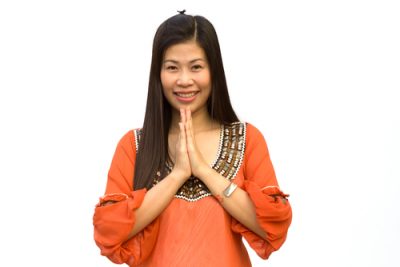Learn How and Why of the “Wai” — Greetings in Thailand
If you’ve never been to Thailand before, chances are you will be charmed by the warm welcome you experience from the Thai people when you arrive. And from your first minutes in the country, you’ll observe the way we greet you (and each other). It’s a gesture, called the wai.
The wai is a gesture you make by placing your palms together (like you are praying) and holding your hands close to your chest with your fingertips close to your chin, while nodding or bowing your head. And if somebody wais you, you wai them back.
But to really understand the wai and properly execute it, you have to keep in mind two cultural dimensions — that not everybody is equal – and that we pay more attention to the context than to the content when communicating. Here’s what I mean.
The wai is not only a greeting, the way you do it communicates that you understand the other person’s status (Remember? Actions speak louder than words in our culture.) The wai is always initiated by a person of lower status to a person of higher status.
Younger people offer a wai to older people; students offer a wai to teachers; employees offer a wai to employers; hosts offer a wai to guests; the taxi driver offers the wai to you. And everybody offers a wai to the king, to monks, or to people who are regarded universally as more important.
Where you put your hands and how deeply you bow depends entirely on how important the person is. And how you return it depends on your status.
Here are the finer points of doing a proper wai:
1. The deepest or strongest wai is reserved only for monks. Instead of holding your touching palms close to your chest, you raise them up so that your thumbs touch the space between your eyebrows, and you bow very deeply and stoop so your head and shoulders are lower than the monk’s.
2. If you’re greeting an elderly or senior person, your thumbs should touch your nose and your fingertips should touch between your eyebrows, and you bow deeply.
3. And for anybody else you respect (including people that have the same status as you), your hands are close to your chest with your fingertips near your chin as you nod your head.
The universal greeting is to say “sawatdi” (sah – wah – dee) any time of the day. As a man, you would add the word “khrap” – “sah-wah-dee-khrap.” Women will say “sah-wah-dee-kha.” Very close friends might not wai each other, only offering these words of greeting whether it’s early in the morning or late at night.
And one more piece to the manners of meeting and greeting people is the polite way to use their names. During social, business, or formal events, we do not usually call people by their first name or nickname until we know them well. And we don’t use their last names. Instead, we use the title “Khun” in front of their first name. If your name is Greg Wilson, and we are meeting you for the first time, we’ll address you as “Khun Greg.” We’re calling you, in effect, “Mr. Greg.” And we won’t call you just “Greg” until we know you well.
So if you master the wai, and remember the name courtesy when you meet someone for the first time (like any Thai ladies you date or people you’d like to do business with), you will make a very good first impression!
We are a matchmaking company that has built an internationally respected reputation for providing the highest quality dating services for Western guys seeking a long-term, committed relationship with a Thai woman as well as Visa Assistance.
We also host Dating Events where you can meet single, lovely and trustworthy Thai ladies who are looking for genuine relationship.
Interested to know what we do? Send us a message and we will be happy to chat.









